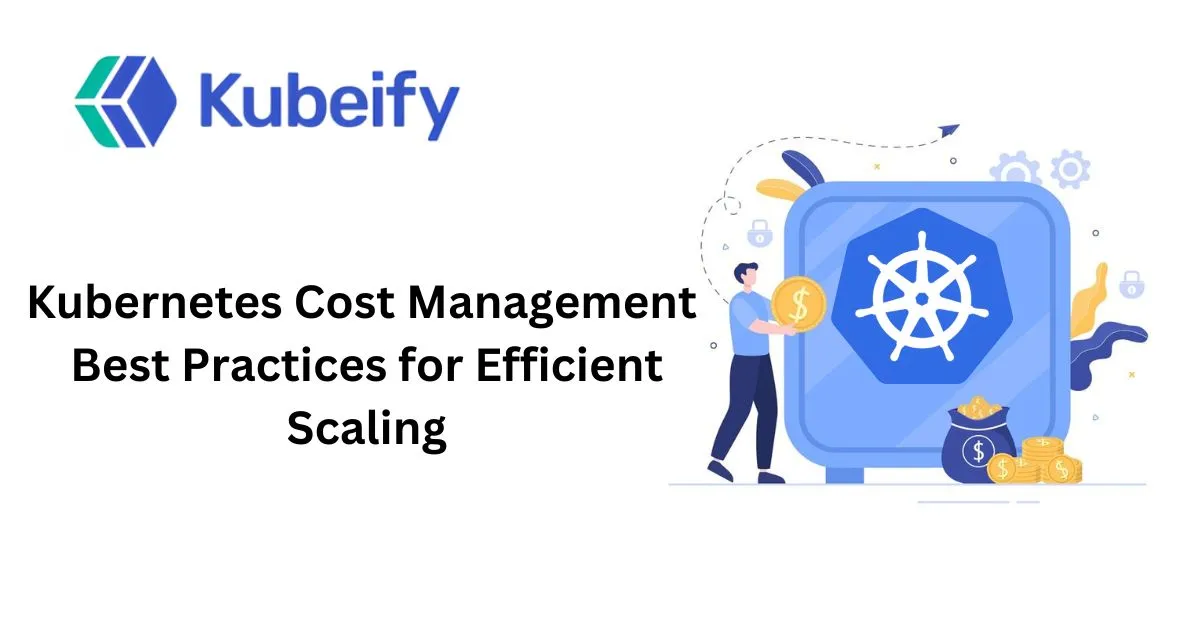AI Cloud
- Cloud Native Product Development
- Cloud Native FaaS
- Monolith to Microservices
- DevSecOps as a Service
- Kubernetes Zero Downtime

As more organizations adopt Kubernetes for container orchestration, it becomes increasingly crucial to manage and optimize its costs.
Kubernetes can be an incredibly powerful tool for scaling applications, but without proper cost management strategies, expenses can quickly spiral out of control. Here are some best practices to ensure your Kubernetes cluster scales efficiently while keeping costs in check!
One of the most important aspects of cost optimization in Kubernetes is right-sizing. If you allocate too many resources (CPU, memory) to pods, you’ll end up over-provisioning and wasting money. Conversely, under-provisioning can lead to performance degradation. Finding the right balance is key!
Best Practices:
● Use Horizontal Pod Autoscaling (HPA) : Automatically adjust the number of pods in your deployment based on CPU utilization or custom metrics.
● Use Resource Requests and Limits : Define appropriate CPU and memory requests and limits for your pods to ensure efficient resource utilization.
If your workload can tolerate interruptions, utilizing spot instances (or preemptible VMs in some cloud providers) can result in significant cost savings. Spot instances are cheaper than regular instances and are ideal for non-critical, stateless applications.
Best Practices:
● Combine spot instances with Kubernetes’ node autoscaling to dynamically adjust the number of nodes based on demand.
● Use taints and tolerations to ensure that critical workloads do not get scheduled on spot instances.
Cluster Autoscaler automatically adjusts the number of nodes in your cluster depending on the demand for resources. Efficient scaling helps avoid over-provisioning and reduces cloud infrastructure costs.
Best Practices:
● Configure proper node pool sizes: Set up different node pools with varying instance types (e.g., large for heavy workloads, small for lighter tasks).
● Monitor cluster resource usage: Use Kubernetes monitoring tools like Prometheus and Grafana to track utilization and make data-driven decisions on scaling.
Using cost management tools helps you visualize and track your spending more effectively. Many cloud providers offer native tools for this purpose. Additionally, there are third-party solutions designed for Kubernetes environments.
Best Practices:
● Cloud Provider Cost Management: Use tools like AWS Cost Explorer or Google Cloud Cost Management to monitor and analyze your cloud spending.
● Kubernetes-specific tools: Tools like Kubecost and Kubernetes Cost Analysis allow you to break down your Kubernetes resource costs by individual services, making cost allocation more transparent.
Networking costs can quickly accumulate, especially in a distributed Kubernetes environment. To reduce this, focus on optimizing network usage and minimizing data transfer between services.
Best Practices:
● Use internal load balancers instead of public ones to avoid additional data transfer costs.
● Configure network policies to reduce unnecessary inter-service communication and control traffic flow.
Constant monitoring is essential for keeping costs under control. Setting up automated alerts allows you to be notified when you exceed predefined budget thresholds or if any unusual behavior is detected in your Kubernetes cluster.
Best Practices:
● Use Prometheus and Grafana to create dashboards and set up cost-related alerts.
● Enable budget alerts from your cloud provider to get real-time notifications when your usage exceeds the expected amount.
Cost management is not a one-time task but a continuous process. As your workload and scaling requirements evolve, so should your approach to managing Kubernetes costs.
Best Practices:
● Review resource usage periodically: Conduct regular audits of your Kubernetes workloads and resource utilization to identify areas of improvement.
● Optimize workloads: Review pod definitions and configurations to ensure that you’re running the most efficient setups.
Sharing Kubernetes clusters across different teams or workloads (multi-tenant clusters) can improve resource utilization and reduce costs by consolidating workloads on fewer nodes.
Best Practices:
● Use namespaces and resource quotas: By dividing the cluster into namespaces, you can control resource usage and allocate resources per team or application.
● Use Network Policies for Isolation: Ensure tenants are securely isolated to avoid unnecessary contention and ensure proper resource allocation.
Cost allocation and chargeback models are crucial when managing Kubernetes at scale, especially in multi-team environments. By allocating costs based on the resources consumed by different teams or applications, you can make informed decisions on resource usage.
Best Practices:
● Chargeback/Showback Models: Create cost allocation strategies to split the cloud bill proportionally across different teams, departments, or workloads.
● Tag Resources Properly: Label or tag your Kubernetes resources appropriately (e.g., app=frontend, team=finance). This helps track and allocate costs more easily.
Container image size impacts both performance and cost. Smaller images not only consume fewer resources when running but also result in faster startup times and reduced storage costs.
Best Practices:
● Use smaller base images: Opt for minimal base images like Alpine Linux to reduce the size of your container images.
● Remove unnecessary dependencies: Strip down images by removing build tools, cache, or any files that aren’t needed at runtime.
A Pod Disruption Budget ensures that your Kubernetes pods are not terminated in large quantities, which helps maintain application availability during scaling activities (like node drains or voluntary disruptions).
Best Practices:
● Set appropriate PDBs: By setting appropriate Pod Disruption Budgets, you can ensure that your applications remain resilient during maintenance events without triggering unnecessary pod scaling.
● Automate PDBs via Helm charts: If using Helm for deployment, automate the creation of Pod Disruption Budgets to align with your scaling strategy.
Often, development and testing environments are over-provisioned or scale inappropriately. Scaling these environments like production clusters leads to unnecessary costs.
Best Practices:
● Use smaller instance types for dev/test workloads: In non-production environments, use smaller instance types or spot instances that are less expensive.
● Set shorter scaling windows: Configure autoscalers with more aggressive scaling policies in dev environments to scale down quickly during low-usage times (e.g., after working hours).
Storage management can be another source of inefficiency in Kubernetes, especially when dealing with persistent volumes. Kubernetes doesn’t automatically optimize storage, so it’s essential to choose the right storage options to keep costs manageable.
Best Practices:
● Use volume lifecycle policies: Set policies for the automatic deletion of unused volumes. Kubernetes Persistent Volume Reclaim policies can help automate this.
● Evaluate storage options: Choose the right type of persistent storage (e.g., SSDs vs HDDs) based on your workload requirements, avoiding over-provisioning of high-cost storage for low-demand applications.
Anomaly detection can help you identify unusual spending patterns or cost spikes in your Kubernetes environment. This can prevent large, unexpected bills and quickly highlight inefficiencies.
Best Practices:
● Automated anomaly detection: Use tools like Kubecost or cloud-native services like AWS Cost Anomaly Detection to automatically detect irregularities in your Kubernetes resource usage and cost.
● Implement cost forecasting: Forecast future costs based on current trends, allowing your team to predict and manage budgets proactively.
Not all workloads need to be run on Kubernetes. For certain types of applications (like microservices or event-driven apps), you may want to explore serverless or FaaS (Function as a Service) options.
Best Practices:
● Evaluate serverless options: Platforms like AWS Lambda, Google Cloud Functions, and Azure Functions allow you to run workloads without managing servers, potentially reducing costs by eliminating idle resources.
● Hybrid approach: Combine Kubernetes with serverless architectures for optimized cost savings. For example, Kubernetes can manage stateful workloads, while serverless handles event-driven or stateless operations.
Cloud providers offer cost-saving programs such as reserved instances or commitment plans where you can commit to a specific usage level over a long period in exchange for discounted rates.
Best Practices:
● Evaluate Reserved Instances: If you can predict your usage, consider committing to reserved or savings plan instances for predictable workloads in your Kubernetes cluster.
● Monitor usage and adjust accordingly: Periodically review reserved instance usage and adjust capacity to avoid paying for unused resources.
Kubernetes is a fantastic tool for scaling your applications, but cost management is crucial to avoid overspending. By implementing these best practices—right-sizing resources, using spot instances, optimizing storage, leveraging cost management tools, and continuously refining your approach—you can keep costs under control while still unlocking the full potential of Kubernetes.
Efficient scaling with cost management is all about strategy and optimization. By continuously monitoring, adjusting, and using the right tools, you can create a Kubernetes environment that grows with your needs while keeping your budget intact.
Start implementing these strategies today to achieve more scalable and cost-efficient Kubernetes deployments tomorrow!

Kubeify's team decrease the time it takes to adopt open source technology while enabling consistent application environments across deployments... letting our developers focus on application code while improving speed and quality of our releases.
– Yaron Oren, Founder Maverick.ai (acquired by OutboundWorks)
Let us know what you are working on?
We would help you to build a
fault tolerant, secure and scalable system over kubernetes.
